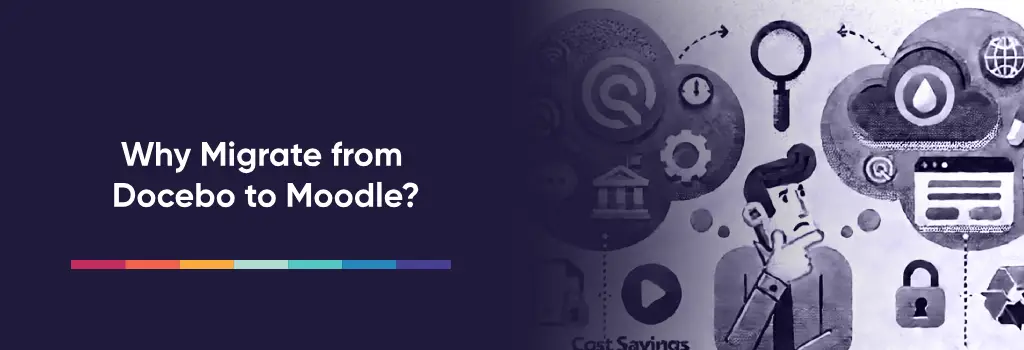As your organization evolves, so do your learning platform needs. Docebo is a strong SaaS based LMS, especially for enterprises focused on out-of-the-box solutions. But when you require more control, customization, and cost-efficiency, Moodle becomes a compelling alternative. Whether you want full control over your data, need to tailor learning paths, or reduce per-user costs, migrating from Docebo to Moodle can be a strategic move.
I recently migrated my site to Mindfield from another host, and the experience couldn’t have been better. Mindfield kept working until they were certain that my site was operating as well as it was before, and they even helped clean up a few issues to improve my site’s performance – issues my prior host never mentioned. I also found Mindfield’s communication to be excellent. Before the migration, they prepared me for what to expect, and during the migration they kept me well-informed. No small feat considering that changing hosts is inherently stressful! They also provided clear and concise explanations when required. I’d highly recommend Mindfield if you’re looking for an IT consultant, developer, or host.
Jim Benedek
Owner, Student First Media Inc.
review Source: Google Reviews
Outline
Why Migrate from Docebo to Moodle?

As your organization grows, your learning platform must evolve with it. While Docebo is a capable SaaS LMS for many companies, a growing number of organizations eventually discover that its strengths come with limits. Moodle solves many of these challenges by giving you more control, flexibility, and cost efficiency.
Here is how Moodle directly addresses common frustrations shared by Docebo users:
1. Cost efficiency at scale
Enterprises often find that Docebo’s per-user pricing, plus add-ons and premium modules, can lead to costs four to five times higher than a comparable Moodle setup. With Moodle, you pay only for what you use. Its open-source model removes expensive licensing fees and lets you decide which services to maintain in-house or outsource. For large teams, schools, and nonprofit organizations, this difference quickly becomes substantial.
2. Focus on essential features, not unused extras
Docebo includes many advanced features that not every organization needs. Some users mention that the platform feels cluttered or that certain functions go unused. Moodle allows you to streamline your LMS by including only the features your learners and administrators truly need. You can add functionality through plugins or custom configuration when necessary, without paying for layers of unused tools.
3. Freedom to customize and adapt
Docebo offers configuration options, but users often report that flexibility is limited when building reports, designing layouts, or setting advanced workflows. One reviewer noted that “custom reports do not work the way that we are looking for.” Moodle gives you full freedom to create your ideal learning environment, from role structures and dashboards to analytics, integrations, and automation workflows. You are not bound by the restrictions of a hosted platform.
4. Full ownership of your data and infrastructure
In a hosted system like Docebo, your data and environment reside within the vendor’s architecture. That can limit access and integration options, especially in education, healthcare, or government sectors where compliance and data sovereignty are critical. Moodle allows you to fully own your data and choose how and where it is hosted. You can control backups, reporting, and integrations without relying on a third-party roadmap.
5. Consistent and unified user experience
Some users have mentioned that “sections of the software appear to be at different ages of development,” leading to a mix of old and new design elements. Moodle, on the other hand, enables complete control over your visual design and user flow. You can create a clean, consistent experience for learners, instructors, and administrators across all devices.
6. Easier implementation and long term flexibility
Docebo’s rich feature set also means a steeper learning curve. As one reviewer said, “Learning Docebo could be a job in itself.” Moodle lets you start simple and expand over time. You can build a basic site and grow into advanced workflows as your internal capacity increases. Partnering with certified Moodle experts provides added support without locking you into the vendor’s pricing or release schedule.
7. Scalable structure for complex organizations
When expanding across regions, brands, or departments, Moodle supports multi-tenant and delegated administration setups through extensions like Iomad. Each division can maintain its own branding, data separation, and permissions while remaining under a single, centralized framework. This structure gives growing organizations more flexibility than a single-tenant SaaS model.
Migrating from Docebo to Moodle is more than a platform change. It represents a move from operating within fixed limits to building an LMS that reflects your organization’s goals, scale, and identity. For those seeking control, cost efficiency, and continuous adaptability, Moodle offers a future-ready foundation.
Migration Planning

A successful LMS migration starts long before the data transfer. This phase involves understanding your current Docebo setup, aligning stakeholders, and defining your new Moodle architecture.
Step 1: Stakeholder Alignment
Involve IT, learning designers, department heads, and compliance officers early. Identify:
-
Who owns what data?
-
Who needs admin or editing access in the new system?
-
What timelines are acceptable?
Step 2: Audit Your Current LMS
Export and review the following:
-
Courses and learning plans
-
Users, groups, and roles
-
SCORM packages and multimedia assets
-
Certificates, grades, and transcripts
-
Automated workflows, notifications, and API connections
Step 3: Define Your Future Moodle Structure
Decide on:
-
Hosting method: self-hosted, managed cloud, or vendor-supported
-
Site hierarchy: flat vs. nested categories, cohorts, tenant separation (via Iomad)
-
Theme and UX strategy
-
Required Moodle plugins (e.g., report builders, gamification, analytics)
Migration Strategies

Not all migrations are the same. The right approach depends on your content complexity, timeline, and technical capacity. Here are the three most common strategies:
Strategy 1: Manual Rebuild with Clean Setup
Overview: You recreate your course structure, roles, and workflows directly in Moodle.
Best for: Organizations that want to eliminate technical debt, streamline UX, or completely reimagine their learning experience.
Steps:
-
Use Docebo exports for reference
-
Manually recreate courses and activities
-
Upload SCORM and media assets into repositories
-
Assign roles and cohorts using CSV uploads
-
Test each workflow in staging before go live
Pros:
-
Full control over structure and quality
-
Great for long term maintainability
Cons:
-
Labor-intensive
-
Requires strong Moodle familiarity
Strategy 2: Hybrid Migration with Format Mapping
Overview: Combine automated export/import tools with selective manual cleanup.
Best for: Organizations that want a faster transition without compromising on structure.
Steps:
-
Export SCORM files, CSVs for users, and quiz data in supported formats (GIFT, XML)
-
Import into Moodle using native tools or plugins
-
Clean up roles, course layout, and gradebook settings
-
Preserve user passwords if possible, or trigger password resets
Pros:
-
Balanced speed and control
Cons:
-
Potential for content mismatches
-
Still requires significant validation
Strategy 3: API-Based Extraction and Scripting
Overview: Use Docebo’s API to extract user data, course progress, learning records, and completions.
Best for: Enterprises with technical teams or vendors who want to retain historical analytics and automate part of the migration.
Steps:
-
Use Docebo API to pull JSON or XML data
-
Map fields to Moodle database schema or use custom import scripts
-
Validate data integrity using SQL reports or plugins like Configurable Reports
Pros:
-
Ideal for heavy data environments
Cons:
-
Requires developer expertise
-
Not all Docebo fields map cleanly to Moodle
Want to Learn More?

If you are preparing for a smooth transition from Docebo to Moodle, or simply exploring ways to improve your Moodle environment, these resources will help you plan, optimize, and evolve your learning platform with confidence:
Each article offers actionable insights to help you plan, implement, and refine your learning platform with confidence.
Bringing in the Pros: Why Moodle Expertise Matters in Migration

Hiring Moodle experts can significantly streamline the migration process and ensure a successful long-term transition from Docebo. While Moodle offers unparalleled flexibility, it also comes with a steeper learning curve, particularly when configuring roles, migrating complex course structures, or integrating third-party tools. Experienced Moodle consultants bring deep technical knowledge and hands-on experience to avoid common pitfalls, preserve data integrity, and rebuild learning experiences in a way that matches your goals.
Beyond the initial migration, Moodle experts can help you optimize site performance, set up advanced reporting, implement multi-tenancy (e.g., via Iomad), and train your internal team. They can also assist with plugin selection, theme customization, and compliance considerations, saving your organization time, reducing costs, and ensuring your new LMS scales with your needs.
Frequently Asked Questions (FAQs)

